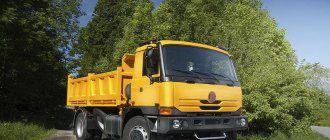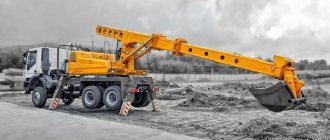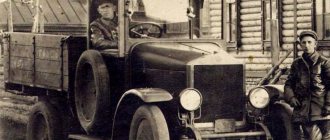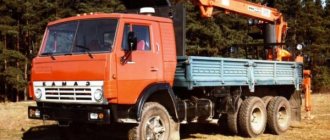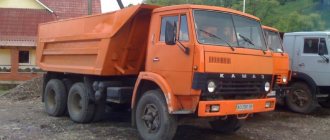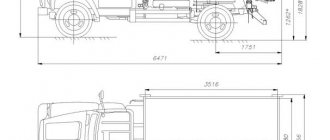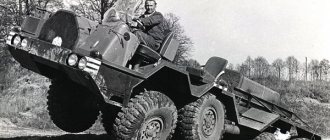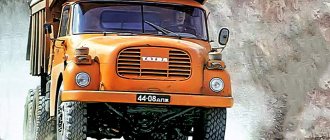The TATRA automobile brand is a true patriarch in the family of self-running strollers. Unfortunately, this is an endangered species, because in 2012 only 496 trucks rolled off the assembly line in the Czech city of Kopřivnice.
It all began in 1850 with the production of horse-drawn phaetons and chaises. The founding father of the company was Ignaz Šustala . The chaises were excellent, half of Europe drove them, and Schustala & Company workshops operated even in Kyiv and Chernivtsi.
Closer to the 20th century, the company switched to the production of railway cars, and the first car in Europe (and this is a historical fact) was assembled by it in 1897. In general, Henry Ford can nervously smoke on the sidelines, as they say. For the first time, a red nameplate with the inscription TATRA on the radiator grill of a car appeared in 1919.
ZIL dump trucks have also not been leaders for a long time, although they continue to be used for agricultural purposes.
Cars
company produced both cars and trucks , as well as self-propelled chassis for artillery systems. The assembly of military equipment, which has special requirements for cross-country ability, load capacity and reliability, predetermined the final specialization of the plant in Kopřivnice as a manufacturer of multi-axle diesel off-road trucks. They work in the construction, forestry and oil industries.
Currently, the T815 truck is produced under the TATRA brand, the production of which began in 1983. This is a whole family of cars on two, three, four, five and even six axles.
Cars from the manufacturer
Over more than thirty years of production history, the T815 has undergone repeated modernizations. Both externally, improving the appearance and ergonomics of the workplace, and radically technical - in 2000, production began of cars with an engine with a liquid cooling system, which had not been installed on Tatras before.
Learn the differences between track loaders and wheel loaders.
One of the leaders in the production of loaders is the French company MANITOU.
Russian loaders are also not inferior in quality.
TATRA returns to Siberians
Tatra Phoenix is a series of trucks created in collaboration between the Tatra manufacturer and the Dutch DAF. The work on creating the transport was carried out for 15 months, which allowed the developers to eliminate the existing comments, while maintaining the features of the Tatra brand regarding a reliable and unpretentious suspension. These features allow you to operate the vehicle in different conditions and be confident in its reliability.
Area of use of the Tatra Phoenix truck
The first Tatra Phoenix trucks appeared in 2011, and since then they have been produced in many modifications. Transport is used in the following areas:
- Elimination of accidents due to leakage of harmful substances.
- Transportation of cargo and waste during construction work.
- Use as a crane.
- Drilling.
- Use as a fire truck.
- Work in quarries.
- Export of agricultural products, etc.
T815 dump trucks
The automobile plant in Kopřivnice produces several models of TATRA T815 dump trucks. Their technical characteristics differ in load capacity, wheel arrangement, and unloading method . Compare them with the characteristics of Howo dump trucks. But what they have in common is that all these cars are all-wheel drive. Their cross-country ability allows cargo to be delivered along any, even just designated roads.
Everyone who has ever worked on these machines notes their high reliability and well-thought-out ergonomics of the driver’s workplace. The Lawn Next dump truck also features excellent ergonomics in the driver's cab.
The photo shows Tatra 815, model 2A0 S01 dump truck.
Dump truck model
2A0 S01
A vehicle with a 6x6 wheel arrangement. The drive axles are rear. The front one is engaged through the center differential. The body is heated, volume 10 m3, load capacity 17 tons. The cabin is double, reclining.
There are models in a “polar” design that have a pre-heater. Unloading only backwards.
290 S24
290 S24
Like the previous model, it has three drive axles. But the front axle is connected rigidly , and it is possible to lock the differential. The volume of the heated body is two cubic meters larger, higher and the load capacity is 19 tons. A similar model in terms of carrying capacity is MAZ 20 tons.
The rear suspension design uses steel sheets and pneumatics. The transmission is equipped with a number of low gears. Unloading of bulk cargo is also backwards.
290 S84
290 S84
Four-axle all-wheel drive dump truck. A rear-tipping body can be of two types :
- unheated, volume 16 m3;
- warm (from exhaust gases), volume 14 m3.
The model with a smaller volume body is considered a “polar” design. It is equipped with an engine pre-heating system and a “warm” battery compartment.
280 S45
280 S45
Two-axle all-wheel drive model. The body is unheated, with a volume of 8 m3, unloaded on any of three sides. The front axle is connected via an axle differential and can be locked. The manual transmission is complemented by a number of reduction gears.
The front suspension is torsion bar with telescopic struts. Rear combined - pneumatics, springs, telescopic struts. The cabin is short, double , and has a heater-air conditioner (diesel fuel).
The car can be used as a tractor. Body volume 8 m3, load capacity 8.5 tons.
280 S25
280 S25
Dump truck with 6x6 wheel arrangement. The body is unheated and unloaded on three sides. The transmission has an additional gearbox with a number of low gears. Switching them is possible only when the machine is completely stopped . Body volume 9 m3.
Load capacity 16.4 tons. The front suspension is torsion bar, the rear is pneumatic. All axles are connected via a center differential. The cabin is double, equipped with a diesel heater.
| 2A0 S01 | 290 S24 | 290 S84 | 280 S45 | 280S25 | |
| Wheel formula | 6x6 | 6x6 | 8x8 | 4x4 | 6x6 |
| Load capacity (t) | 17 | 19 | 24,6/25,3 | 8,5 | 16,4 |
| Body volume (m3) | 10 | 12 | 16/14 | 8 | 9 |
| Engine (type, number of cylinders, volume) | Diesel, 8, 12.7 | Diesel, 8, 12.7 | Diesel, 8, 12.7 | Diesel, 8, 12.7 | Diesel, 8, 12.7 |
| Power l. With. | 326 | 405 | 367 | 367 | 367 |
| Low gears | 1 | 2 | 2 | 2 | 2 |
| Curb weight (t) | 13 | 13,5 | 15,2 | 9,9 | 12,1 |
| Overall length (m) | 7,375 | 7,66 | 8,58 | 6,77 | 7,66 |
| Ground clearance (cm) | 29 | 29 | 32 | 23,5 | 26 |
| Unloading | Back | Back | Back | On three sides | |
Main parameters of the model
The release of the Tatra 815 dump truck was preceded by the production of the Tatra 148 model, which showed endurance and high performance even in extreme operating conditions. The designers provided this dump truck with specific parameters:
Tatra 148
- four-stroke diesel engine;
- enhanced engine cooling system;
- supporting frame with strong fixation of the body and components;
- reliable wheel arrangement (max – 12*12).
The design of the dump truck was considered innovative during Soviet times. The modern world of technology has spoiled the consumer with high-tech decor, but the Tatra 815 still looks decent compared to newer units.
The configuration of the special equipment meets all technical requirements and fully complies with the tasks assigned to the dump truck. The front stems distribute the load and act as shock absorbers. The external profile of the dump truck also has a specific shape that protects the internal structure of the vehicle. The chassis of the Tatra 815 dump truck can withstand loads of up to 16,600 kg and has various modification options depending on additional equipment.
Despite numerous improvements in characteristics, this car is characterized by high fuel consumption: about 20 liters of fuel are consumed per 50 km of travel. The level of gasoline consumption also depends on the weight of the cargo being transported.
Design Features
TATRA dump trucks are very unusual vehicles, the design of which has unique elements. First of all, it is worth noting that this is practically the only brand of trucks that are equipped with air-cooled diesel engines. This significantly simplifies their design, but places greater demands on the driver’s qualifications, because the temperature regime of the engine is more intense.
You've probably already noticed that almost identical cars have different numbers of axles. This became possible thanks to the use of a backbone frame, which is also a feature of the TATRA brand .
Dump truck Tatra T815
A number of rear axle shafts (on the Tatras they are made to swing, which makes the suspension completely independent and increases the vehicle’s maneuverability) can be supplemented by mechanically extending the central beam, on which all power units and transmission are mounted.
However, what is good for designers and designers turned out to be not very convenient in operation. All cardan shafts are located inside the beam and access to them is extremely difficult.
Another feature of this brand is heated bodies, into the cavities of which exhaust gases enter . This, of course, is not a revolutionary solution, but it is quite rare. Shakman dump trucks also have a similar solution.
The video shows the Tatra T815 dump truck in action
In general, the videos with which you can watch here are outstanding representatives of the independent development of design thought. And the sale of the plant in Kopřivnice to the MAN concern, which took place in 2013, has not yet greatly influenced their originality.
Technical specifications in numbers
- Cabin height – 1,970 mm;
- Loading platform width – 2,400 mm;
- Loading platform length – 4,310 mm; its height grows, expanding its carrying capacity, and varies widely;
- Gross weight – 28500 kg;
- Permissible load on the front axle – 6300 kg;
- Rear axle load – 22200 kg;
- Maximum speed – 90 km per hour;
- Fuel tank volume – 320 liters;
- Standard diesel fuel consumption is 45 liters per 100 km.
Ergonomics eight hundred and fifteen
“Eight hundred and fifteenth Tatra” is a workhorse without any special frills. It can be characterized, for example, by a phrase from the movie “World Guy”: “Well, you’re not a dude, you can do anything!” Although to say that the atmosphere in the Tatra cockpit is absolutely spartan would mean sinning against the truth.
It has a tilting cab, placed above the engine. Therefore, like all cars with a hood in the cabin, the noise level is higher than, for example, in cars from Mack or Peterbilt.
When creating the T815, designers were able to reduce this figure three times compared to its predecessor, the T148.
In 2003, during the next “facelift”, a slight adjustment to the appearance was accompanied by a change in the dashboard (its shape remained almost identical, several buttons and indicators were added), and the area of the windshield also increased slightly.
The cabin heating remains the same - from an autonomous diesel heater , which is not very good, since you have to breathe a mixture of air with combustion products of diesel fuel. But another solution is not possible in machines with an air-cooled engine.
Why do the Tatra's rear wheels not cross the axle axis?
Here's a little about TATRA, I don't remember where it was taken from:
The design of the engine (this is an eight- or ten-cylinder air-cooled diesel engine) contains many rare and original solutions. The tunnel crankcase - essentially a pipe - houses only the crankshaft. Outside, two rows of cylinders are installed in a V-shape, reminiscent of motorcycle cylinders in their fins and mounting method. In front, in the camber between the cylinders, there is an impressively sized axial fan and a clever deflector: it directs air not only to cool the cylinders, but also to the engine’s two oil radiators. Lubrication system - dry sump. The pumping section of the oil pump (much more efficient than the injection section), collecting oil in the sump, directs it to the radiators. Having given off excess heat there, it enters the oil tank, settles from foam and is again supplied to the engine, to the connecting rod journals of the crankshaft. The main ones do not need lubrication under pressure - they are on roller bearings. The crankshaft itself is collapsible: essentially, a set of connecting rod journals, tightened with flanges on “finishing” bolts.
The advantage of this design is its excellent maintainability. If the regrinding limit has been exhausted (four repair sizes) or the crank pin cannot be repaired for another reason, it can simply be replaced - this is much cheaper than the entire shaft.
The high thermal stress of the pistons (their Teflon-coated skirts) of the “air vent” is compensated by jet cooling - a nozzle is installed under each piston, directing a stream of oil from below to its bottom. The separate aluminum cylinder heads are notable for the fact that, for layout reasons, the gas distribution mechanism uses rocker arms of different lengths - their own for the intake and exhaust valves.
Concluding the story about the engine, we note that it is equipped with two electric starters - another plus in favor of survivability.
The clutch is also “not like people’s” - it works “topsy-turvy”: instead of the usual movement of the release bearing forward, it moves backward. But replacing a worn driven disc (single-plate clutch with a diaphragm spring!) is not difficult, and the repairmen are very pleased with it.
A special feature of the gearbox is an aluminum crankcase with a split plane along the axis of the shafts. This achieved the necessary rigidity of such a loaded unit. The box is located above the central support pipe (more on that later), so removing it for repair is easy.
The frame and transmission follow family traditions, starting with the Tatra-11 passenger car of 1923 (by the way, in 1926 it was taken as the basis for the first Soviet small car NAMI-1). To this day, a feature of all Tatra trucks remains the backbone frame and swing axle shafts.
Such designs were “fashionable” at the beginning of the last century. In the 1908 Ford T, the pipe through which the drive shaft passed absorbed reactive torques. Something similar can be seen on the Ford-AA, which was later produced by GAZ (GAZ-AA). At the same time as the Tatra, but on the other side of the Earth, in the USA, they were making the Makk-AS, which had a chain drive to the drive wheels. But only Tatra retained its unique design, fine-tuned it, nurtured it, and entered the new century with it.
The consequence of this scheme is a congenital “clubfoot”, thanks to which the Tatra cannot be confused with any truck. But this, of course, is not the main thing. Another advantage is the independent suspension of all wheels, which ensures a smooth ride and excellent cross-country ability, and high bending and torsional rigidity of the central supporting pipe - the spinal frame. Cracks in the side members of ladder-type frames are a problem for many dump trucks and chassis with heavy special equipment (cranes, excavators, drilling rigs, etc.). But not the Tatras. Fatigue failures here are incredible events.
The engine torque is transmitted through the gearbox and transfer case along transmission shafts running inside the central support tube, to spur differentials (again in the tube) and to the side gears. The latter are conical, with a spiral tooth, one for each wheel, and sit rigidly on swinging axle shafts. To ensure this swing and do without “capricious” cardans and CV joints, an original solution was used - each wheel has its own main gear and the axes of the right and left sides are offset from each other by 55 mm along the pipe. So, strictly speaking, Tatra is not only “club-footed”, but also “lopsided”.
All four differentials (center and three cross-axle) are lockable, with electric pneumatic drive, which further increases cross-country ability.
The front suspension is almost like a tank - independent, with longitudinal torsion bars. Their advantages are simplicity, high reliability, service life and easy replacement in case of breakdown. In addition, it is possible to adjust the rigidity by changing the preliminary twist of the torsion bars. And thanks to the enormous rigidity of the supporting pipe, the Tatra is capable of such a trick as driving without one front wheel. This makes a stunning impression on the uninitiated, but it is a useful property, allowing the driver, even if the bearing unit breaks down, etc., to get to the garage without outside help.
The rear suspension is independent, balanced, with two semi-elliptic springs. There are no reaction or pushing rods - all loads are taken by the axle shaft casings (“stockings”), hinged in the main gear housings. Despite the many advantages of this scheme, it has a known drawback - uneven tire wear. An empty car mostly rides on the outer wheels, a heavily loaded car rides on the inner wheels. However, the designers promise to solve this problem soon.
The cabin, unfortunately, cannot be called a masterpiece of design art. The air-suspended seat, levers, pedals, heater - everything seems to be in place. But I was surprised by the abundance of bare metal: the back wall, side panels and partly the doors, devoid of any upholstery, evoke despondency with their orphan appearance. Our KamAZ is finished much more respectably. Looks like most of the eight-kilowatt Eberspächer heater goes to heating this tin. It’s not for nothing that the latest models are equipped with two cabin heaters: “Webasto” - autonomous on diesel fuel and a working one - from the engine lubrication system.
The windshield is a huge panorama for $250! Maybe it’s inexpensive for “them,” but... stones are flying. Therefore, another option has long taken root in Russia - instead of the broken panoramic glass, two large flat glasses are installed, and at the edges there are two small ones from the Tatra-815 model of 1984. In this case, the middle wiper blade has to be sacrificed.
Impressions from the workplace: a spartan, but at the same time comfortable environment. The only thing I didn't like was the steering wheel - it was big and thin. With a powerful hydraulic booster, it could well have been smaller. The movement of the gearbox divider flag is unusual - from left to right. However, after a few minutes spent behind the wheel, it seems that this is how it should be.
The noise from a working diesel “air vent” is not much more than in KamAZ, but we have long learned to deal with this. The main thing is not to spare felt when preparing the car “to suit you”, and you almost don’t feel shaking and rattling in the cabin.
A powerful engine and successful transmission ratios allow the car, as they say, not to feel the load - the clubfooted keeper of traditions knows her business.
